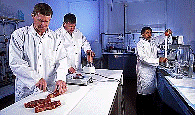United States Department of Agriculture: Agricultural Research Service, Lincoln, Nebraska

Roman L. Hruska U.S. Meat Animal Research Center: Reports
ORCID IDs
Suzanne M. Leonard https://orcid.org/0000-0003-3808-8469
Brett C. Ramirez https://orcid.org/0000-0002-3205-9723
Somak Dutta https://orcid.org/0000-0002-5613-8987
Date of this Version
6-1-2021
Document Type
Article
Citation
Animals 2020, 10, 348
doi:10.3390/ani10020348
Abstract
Farrowing stalls are used in the United States swine industry to reduce pre-weaning piglet mortality, enable efficient individual animal management, and decrease facility construction and operating costs. The quantity and quality of space provided for sows and piglets in farrowing stalls are important economic and welfare considerations. To further explore the impacts of farrowing stall space allocation, a large-scale field study was conducted to compare sow and piglet behavior when housed in three farrowing stall layouts (TSL – traditional stall layout, ECSL – expanded creep area stall layout, ESCSL – expanded sow and creep area stall layout) with either one or two heat lamps (1HL and 2HL, respectively). A computer vision system classified posture budgets and behaviors of 322 sows and piglet location for 324 litters. Linear mixed models were developed to compare behavior and piglet pre-weaning mortality metrics between experimental treatments. Results show sows in ESCSL spent more time lying compared to sows in ECSL (p = 0.028) and less time sitting compared to sows in TSL and ECSL (p < 0.01). Sows with the 2HL treatment had an increase in percentage lying (p = 0.017) and a decrease in percentage standing (p = 0.045) compared to sows with the 1HL treatment. Number of piglets, parity, and batch also influenced sow postural behavior (p < 0.05). Sow lying orientation was not impacted by HL treatment. Sow postures and behaviors were influenced by day of lactation (p < 0.001). Piglets with 2HL treatment spent more time in the heated region and less time in the creep and sow regions for all stall layouts on all days of lactation observed (p < 0.001). In the ESCSL, piglets had a greater percentage of time in the sow region compared to ECSL piglets (p < 0.004). Piglets did not spend equal percentages of time between the two creep or two HL regions (p < 0.001), and piglet location was correlated with sow lying orientation for most of the creep regions analyzed (p < 0.01). Increases in piglet pre-weaning mortality were correlated with increases in sow lying (p = 0.027) and decreases in standing (p = 0.025) and feeding (p < 0.001). However, correlations with sow posture were likely due to the impacts of day of lactation (p < 0.001). No correlations were found between piglet location and pre-weaning mortality (p> 0.05). Results can guide producers to consider wider sow areas in farrowing stalls to better meet sow behavioral needs and to include larger heated areas to meet piglet behavioral needs during lactation.


Comments
This article is an open access article distributed under the terms and conditions of the Creative Commons Attribution (CC BY) license